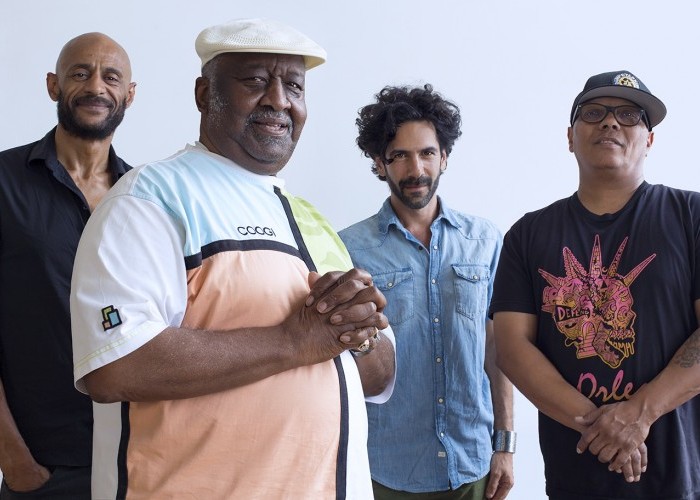Apr 2, 2024 12:59 PM
Saxophonist, Sonic Explorer Casey Benjamin Dies at 45
Casey Benjamin, the alto saxophonist, vocalist, keyboardist and producer who stamped his distinctive sounds on the…

Pete Shand (left), Bernard “Pretty” Purdie, Brian J and Ivan Neville collaborated on the new album Cool Down.
(Photo: Azumi Oe)Forget Aretha Franklin, James Brown, Herbie Hancock and the multitude of other artists with whom Bernard “Pretty” Purdie has played. What most animates the drummer is talk of himself at age 8, in Elkton, Maryland, coming to terms with what would become his signature contribution to music: the Purdie Shuffle.
The Shuffle—that celebrated swirl of “ghost notes” and rock-solid backbeat, at once connected and propelled by the whoosh of the hi-hat opening and closing—was suggested to him by the rhythms of the trains he heard as a youth.
By his own count, he’s been heard on 4,000 records, yet he claims a relatively modest 15 albums as a leader. So, it’s with some excitement that he has released Cool Down (Sugar Road), his first studio leader project in a decade.
The Purdie sound is identifiable throughout these 10 tunes, not least on the instrumental “Golden Tie.” With Purdie’s drums rumbling, the tune recalls the cadences of those trains from the past. But in his own estimation, the sound’s elements reveal themselves most clearly on ballads. The album’s closing number, “Stranded,” features Ivan Neville’s Hammond B3 organ backing the plaintive vocals of his uncle, New Orleans legend Cyril Neville. Despite the tune’s languid pace, it has a propulsive edge and, like most of the tracks on Cool Down, an air of spontaneity.
“I’d start out a groove by myself while the rest of the band was taking a break,” Purdie said. “Next thing I know, they’d jump into the song and away we go.”
Reflecting that, the writing credits for most of the tunes go to the core band—Brian J on guitar, vocals and percussion; Pete Shand on bass; and Ivan Neville on keyboards—along with Brian Gitkin. To Purdie, this is no small matter: “It was a group effort. Everybody wanted to contribute, so that’s how I look at things.”
For Purdie, that was not always the case. In a career spanning more than half a century, he said, the songwriting credit—and the lion’s share of the money—usually went to those who crafted the “single-note” melodies. And don’t even talk about sampling.
“I was the beat for so many records in the ’70s,” he said. “Folks have taken those albums and made their own albums out of them.”
Still, he has no regrets. “I know that I really should be paid more for helping out and supporting the young people today with their songs. But you know what? The man upstairs has given me all these good, fabulous years. He watches over me, and I know that.” DB

Benjamin possessed a fluid, round sound on the alto saxophone, and he was often most recognizable by the layers of electronic effects that he put onto the instrument.
Apr 2, 2024 12:59 PM
Casey Benjamin, the alto saxophonist, vocalist, keyboardist and producer who stamped his distinctive sounds on the…

“He’s constructing intelligent musical sentences that connect seamlessly, which is the most important part of linear playing,” Charles McPherson said of alto saxophonist Sonny Red.
Feb 27, 2024 1:40 PM
“I might not have felt this way 30 to 40 years ago, but I’ve reached a point where I can hear value in what people…

Albert “Tootie” Heath (1935–2024) followed in the tradition of drummer Kenny Clarke, his idol.
Apr 5, 2024 10:28 AM
Albert “Tootie” Heath, a drummer of impeccable taste and time who was the youngest of three jazz-legend brothers…

“Both of us are quite grounded in the craft, the tradition and the harmonic sense,” Rosenwinkel said of his experience playing with Allen. “Yet I felt we shared something mystical as well.”
Mar 12, 2024 11:42 AM
“There are a few musicians you hear where, as somebody once said, the molecules in the room change. Geri was one of…

Larry Goldings’ versatility keeps him in high demand as a leader, collaborator and sideman.
Feb 21, 2024 10:45 AM
Are you having any fun? Larry Goldings certainly is. Consider just two recent examples:
Scene 1: “If anyone had…